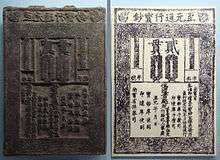Banknote seal (China)
Cash seal (simplified Chinese: 宝钞印; traditional Chinese: 寳鈔印; pinyin: Baochao Yin; "Baochao" means "valuable money", "Yin" means "seal"), is a kind of special seal used particularly in cash authority, or just on paper money or banknotes. It was also one of the first three means that China invented first to distinguish real and fake paper money.
The short name is Chao Yin (simplified Chinese: 钞印; traditional Chinese: 鈔印), and the full name is Seal of Baochao (simplified Chinese: 宝钞之印; traditional Chinese: 寳鈔之印; pinyin: Baochao Zhiyin), or Baochao Yinjian (simplified Chinese: 宝钞印鉴; traditional Chinese: 寳鈔印鑑). The name can also be simply translated as "money seal" or "banknote seal".
History


.jpg)
Such kind of seal first appeared in the Song Dynasty, when China first used paper-based money and governmental financial notes in a large scale.
In Song Dynasty, especially during the Southern Song Dynasty, China's economy volume reached new height, and its oversea trading was booming. The traditional copper or iron coins could not satisfy the demand of money circulation. Under this background, the paper money/banknote so called Jiaozi (交子) was first appeared in China.
The paper money during that time was officially issued and printed by the Song government. But when a lot of paper money printed out and circulated through the society in a large scale, one very serious problem was the appearance of counterfeit money (making fake paper money was illegal and could meet serious punishments including the death penalty). The Song government founded a specialized government department to issue, print, authorize cash, and handle with those fake banknotes and fake money, especially those fake paper ones. It was the first time to found a department of such kind. The Song government also made a kind of special governmental seal, to stamp on every paper money, normally in the center of a money piece, so that people could easily distinguish real money and fake one. Those fake ones nominally lacked such stamp (normally red, occasionally black or purple), or, with fake seal stamps of less quality than the government's seal.
In the Ming[1] and Qing Dynasties' paper money and banknotes, this kind of seals and stamps are often seen. They proves the authenticity of a banknote or paper money. As late as Xianfeng Era (咸豐) of Qing Dynasty, people still could see such red seal stamps on paper money.[2]
In the Ming Dynasty, a special government department named Baochao Ju (寳鈔局 / 宝钞局) or Baochao Bureau, was established to handle the cash affairs of the whole country, and the department had the authority to use this kind of special seal.[3]
Modern time
In modern time, the usage of this kind of seal is not restricted only in government, and was already significantly enlarged. Those personal seals that can be used in private banknotes also appear, which can represent the trust, credit, or authority of a person, or, a company or organization.
In the era of the Republic of China, sometimes people called these seal stamps Yinhang Yin (銀行印/银行印; direct translation: the seal stamp of bank, or just "bank seal").
In Japan, the called Ginko In (Japanese: 銀行印) has quite similar characteristics.
Typical seals
In ancient China:
- 大明寳鈔之印 / 大明宝钞之印 (traditional/simplified Chinese); The Seal of Cash of the Great Ming.
- 大清寳鈔之印 / 大清宝钞之印; The Seal of Cash of the Great Qing.
See also
References
- ↑ The paper money printing in Ming Dynasty Archived July 7, 2011, at the Wayback Machine.
- ↑ Baidu.com Encyclopedia: 宝钞 (Baochao)
- ↑ Minyi Daifang Lu (Waiting for the Dawn; a historic record): "... 上特设内宝钞局,昼夜督造,募商发卖,无肯应者。", recorded by Huang Zongxi in the Late Ming and Early Qing Dynasties